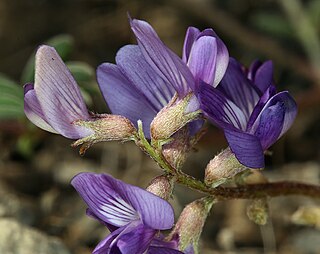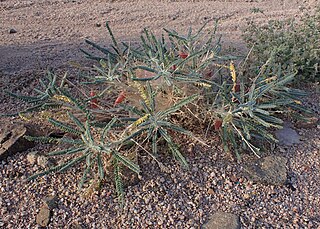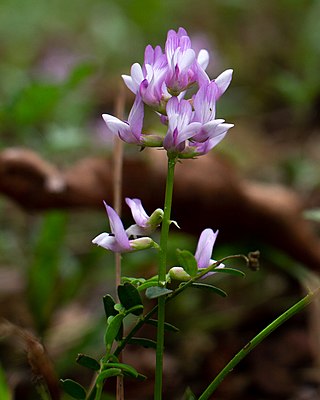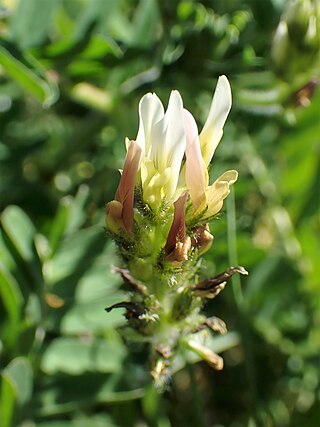
Astragalus is a large genus of over 3,000 species of herbs and small shrubs, belonging to the legume family Fabaceae and the subfamily Faboideae. It is the largest genus of plants in terms of described species. The genus is native to temperate regions of the Northern Hemisphere. Common names include milkvetch, locoweed and goat's-thorn. Some pale-flowered vetches are similar in appearance, but they are more vine-like than Astragalus.

Astragalus newberryi, is a flowering plant in the family Fabaceae, native to the western United States from Idaho to New Mexico and California. A variety is found in the Death Valley area and the eastern Mojave Desert in California and Nevada. It grows in rocky and gravelly areas between 1,300–2,350 metres (4,270–7,710 ft) elevation.

Astragalus mongholicus, synonyms including Astragalus propinquus and Astragalus membranaceus, commonly known as Mongolian milkvetch in English; 'Хунчир' in Mongolian; huáng qí, běi qí or huáng huā huáng qí, in Mongolia, is a flowering plant in the family Fabaceae. It is one of the 50 fundamental herbs used in traditional Mongolian medicine. It is a perennial plant and it is not listed as being threatened.

I. M. Johnston, was a United States botanist. He studied at Pomona College in Claremont, California and at Harvard University. His plant collections are housed in the Rancho Santa Ana Botanic Garden, in Claremont, and also in the Gray Herbarium of Harvard University.

Astragalus lentiginosus Astragalus lentiginosus is a species of legume native to western North America where it grows in a range of habitats. Common names include spotted locoweed and freckled milkvetch. There are a great number of wild varieties. The flower and the fruit of an individual plant are generally needed to identify the specific variety.

Astragalus inyoensis is a species of milkvetch known by the common name Inyo milkvetch.
Astragalus lentiginosus var. pseudiodanthus, synonym Astragalus pseudiodanthus, is a variety of the species Astragalus lentiginosus, a milkvetch. It is known by the common name Tonopah milkvetch. It is native to the Great Basin deserts of Nevada and eastern California, such as the Tonopah area, where it grows in sandy habitat.

Astragalus molybdenus is a species of flowering plant in the legume family known by the common names Leadville milkvetch and molybdenum milkvetch. It is endemic to Colorado in the United States. If the separate species Astragalus shultziorum and Astragalus lackschewitzii are included in A. molybdenum the range expands into Wyoming and Montana.

Astragalus falcatus is a species of milkvetch known by the common names Russian milkvetch, sickle milkvetch, sicklepod milkvetch, and silverleaf milkvetch. It is a flowering plant found primarily in meadows and grasslands and sometimes in open woodlands.
Astragalus cerasocrenus is a species of milkvetch in the family Fabaceae. Its roots are a source of Gum tragacanth, which has many uses. It is native to Northeast Iran and Southern Turkmenistan. It is most commonly found in the months of May, June, and July.

Astragalus dactylocarpus is a species of milkvetch in the family Fabaceae. It is native to the Middle East and Central Asia.

Astragalus sinicus is a species of milkvetch in the family Fabaceae. It is known under such common names as Chinese milkvetch, renge or genge and is in common use in farming as a green manure. It is not to be confused with Astragalus mongholicus, the plant yielding Radix Astragali for Chinese medicine.

Astragalus distortus is a species of flowering plant in the legume family known by the common name Ozark milkvetch. It is found in the central United States. Missouri has a wide distribution of this plant, but is uncommon or absent in the northwestern and southeastern sections of the state. The species is subdivided into two varieties, neither of which is particularly common. There is no vine on the plant in Missouri, and it has small, purple inflorescences. Identifying characteristics include its small size, non-vining habit, and its inflorescences. It is a perennial herb. Its habitats include prairies and savannas.

Astragalus crassicarpus, known as ground plum or buffalo plum, is a perennial species of flowering plant in the legume family, Fabaceae, native to North America. It was described in 1813. The fruit is edible and was used by Native Americans as food and horse medicine. It is a host of afranius duskywing larvae. It is also known as groundplum milkvetch and pomme de prairie.

Astragalus plattensis, the Platte River milkvetch, is a species of flowering plant in the legume family, Fabaceae, native to North America. It was named in 1838. Its range includes the Great Plains of the United States, from southern Montana and North Dakota south to central Texas.
Astragalus bakaliensis is a species of flowering plant in the large legume genus Astragalus (Fabaceae). It is native to central Asia, Iran, and Pakistan. Astragalus bakaliensis was first formally named by Russian botanist Alexander von Bunge in 1851.

Astragalus neglectus, or Cooper's milkvetch, is a species of flowering plant in the family Fabaceae native to northeastern North America.

Astragalus norvegicus is a species of flowering plant belonging to the family Fabaceae.

Astragalus racemosus, the cream milkvetch, is a species of flowering plant in the family Fabaceae. It is native to central North America. A selenium hyperaccumulator, it is considered capable of poisoning livestock as one of the locoweeds.

Astragalus boeticus, the yellow milk vetch, or Swedish coffee is a species of annual herb in the family Fabaceae. It is native to the Mediterranean and the Middle East.

















